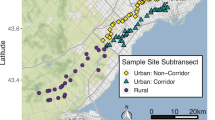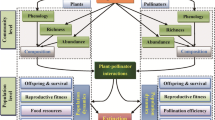Abstract
Urbanization alters the landscape, degrades and fragments habitats, and can have a profound effect on species interactions. Plant–pollinator networks may be particularly sensitive to urbanization, because plants and their insect pollinators have been shown to respond to urbanization both positively and negatively. To better understand the relationship between urbanization, pollinator behavior, and season on pollinator-mediated plant reproduction, we created 30 experimental plant populations along an urbanization gradient in the Greater Toronto Area, Canada. To test how urbanization affects plant reproduction and between-patch pollen dispersal, we created a standard hermaphroditic plant patch at each site, and a male-sterile plant patch at a subset of sites. We measured plant reproduction in the early and late summer in each of 2 years. Plants in urban sites produced significantly fewer flowers than plants in the nonurban sites, whereas seed number per plant either increased or decreased with urbanization, depending on the season. Experimental populations in urban sites also exhibited reduced pollen dispersal between patches. Pollen dispersal between patches was greatest early in the summer and declined with increased impervious surface and proximity to the city. Together, our results are likely caused by variation in environmental conditions and pollinator services across the urban gradient, resulting in pollen limitation and pollen dispersal differences among sites. Our work adds to the small but growing body of literature on urban plant-pollinator interactions and suggests that responses to urbanization are context-dependent.



Similar content being viewed by others
References
Aizen MA, Harder LD (2007) Expanding the limits of the pollen-limitation concept: effects of pollen quantity and quality. Ecology 88:271–281. https://doi.org/10.1890/06-1017
Andrieu E et al (2009) The town Crepis and the country Crepis: how does fragmentation affect a plant-pollinator interaction? Acta Oecol 35:1–7. https://doi.org/10.1016/j.actao.2008.07.002
Aronson MF, La Sorte FA, Nilon CH, Katti M, Goddard MA, Lepczyk CA, Warren PS, Williams NS, Cilliers S, Clarkson B, Dobbs C, Dolan R, Hedblom M, Klotz S, Koojmans JL, Kühn I, MacGregor-Fors I, McDonnell M, Mörtberg U, Pyšek P, Siebert S, Sushinsky J, Werner P, Winter M (2014) A global analysis of the impacts of urbanization on bird and plant diversity reveals key anthropogenic drivers. Proc R Soc B Biol Sci 281:20133330. https://doi.org/10.1098/rspb.2013.3330
Aronson MF, Nilon CH, Lepczyk CA, Parker TS, Warren PS, Cilliers SS, Goddard MA, Hahs AK, Herzog C, Katti M, La Sorte FA, Williams NSG, Zipperer W (2016) Hierarchical filters determine community assembly of urban species pools. Ecology 97:2952–2963. https://doi.org/10.1002/ecy.1535
Baldock KCR, Goddard MA, Hicks DM, Kunin WE, Mitschunas N, Morse H, Osgathorpe LM, Potts SG, Robertson KM, Scott AV, Stone GN, Vaughan IP, Memmott J (2015) Where is the UK’s pollinator biodiversity? The importance of urban areas for flower-visiting insects. Proc R Soc B Biol Sci 282:20142849. https://doi.org/10.1098/rspb.2014.2849
Baldock KCR, Goddard MA, Hicks DM, Kunin WE, Mitschunas N, Morse H, Osgathorpe LM, Potts SG, Robertson KM, Scott AV, Staniczenko PPA, Stone GN, Vaughan IP, Memmott J (2019) A systems approach reveals urban pollinator hotspots and conservation opportunities. Nat Ecol Evol. https://doi.org/10.1038/s41559-018-0769-y
Banaszak-Cibicka W, Zmihorski M (2012) Wild bees along an urban gradient: winners and losers. J Insect Conserv 16:331–343. https://doi.org/10.1007/s10841-011-9419-2
Bates AJ, Sadler JP, Fairbrass AJ, Falk SJ, Hale JD, Matthews TJ (2011) Changing bee and hoverfly pollinator assemblages along an urban-rural gradient. PLoS One 6:e23459. https://doi.org/10.1371/journal.pone.0023459
Burkle LA, Alarcon R (2011) The future of plant-pollinator diversity: understanding interaction networks across time, space, and global change. Am J Bot 98:528–538. https://doi.org/10.3732/ajb.1000391
Calatayud A, Iglesias DJ, Talón M, Barreno E (2003) Effects of 2-month ozone exposure in spinach leaves on photosynthesis, antioxidant systems and lipid peroxidation. Plant Physiol Biochem 41:839–845. https://doi.org/10.1016/s0981-9428(03)00123-2
Cane JH (2005) Bees, pollination, and the challenges of sprawl. In: Johnson EA, Klemens MW (eds) Nature in fragments: the legacy of sprawl. Columbia University Press, New York, pp 109–124
Cheptou P-O, Avendaño V LG (2006) Pollination processes and the Allee effect in highly fragmented populations: consequences for the mating system in urban environments. New Phytol 172:774–783. https://doi.org/10.1111/j.1469-8137.2006.01880.x
Clark AJ, Landolt W, Bucher JB, Strasser RJ (2000) Beech (Fagus sylvatica) response to ozone exposure assessed with a chlorophyll a fluorescence performance index. Environ Pollut 109:501–507. https://doi.org/10.1016/s0269-7491(00)00053-1
Crittenden PD, Read DJ (1977) The effects of air pollution on plant growth with special reference to sulphur dioxide. II. Growth studies with Lolium perenne L. New Phytol 80:49–62. https://doi.org/10.1111/j.1469-8137.1978.tb02263.x
Deguines N, Julliard R, de Flores M, Fontaine C (2016) Functional homogenization of flower visitor communities with urbanization. Ecol Evol 6:1967–1976. https://doi.org/10.1002/ece3.2009
Geslin B, Gauzens B, Thébault E, Dajoz I (2013) Plant pollinator networks along a gradient of urbanisation. PLoS One 8:e63421. https://doi.org/10.1371/journal.pone.0063421
Gorton AJ, Moeller DA, Tiffin P, Gorton AJ (2018) Little plant, big city: a test of adaptation to urban environments in common ragweed (Ambrosia artemisiifolia). Proc R Soc B Biol Sci 285:20180968. https://doi.org/10.1098/rspb.2018.0968
Harrison T, Winfree R (2015) Urban drivers of plant-pollinator interactions. Funct Ecol 29:879–888. https://doi.org/10.1111/1365-2435.12486
Hennig EI, Ghazoul J (2012) Pollinating animals in the urban environment. Urban Ecosyst 15:149–166. https://doi.org/10.1007/s11252-011-0202-7
Hernandez JL, Frankie GW, Thorp RW (2009) Ecology of urban bees: a review of current knowledge and directions for future study. Cities Environ 2:1–15
Hicks DM et al (2016) Food for pollinators: quantifying the nectar and pollen resources of urban flower meadows. PLoS One 11:e0158117. https://doi.org/10.1371/journal.pone.0158117
Idso CD, Idso SB, Balling RC Jr (1998) The urban CO2 dome of Pheonix, Arizona. Phys Geogr 19:95–108. https://doi.org/10.1080/02723646.1998.10642642
Irwin RE, Warren PS, Carper AL, Adler LS (2014) Plant-animal interactions in suburban environments: implications for floral evolution. Oecologia 174:803–815. https://doi.org/10.1007/s00442-013-2797-2
Irwin RE, Warren PS, Adler LS (2018) Phenotypic selection on floral traits in an urban landscape. Proc R Soc B Biol Sci 285:20181239. https://doi.org/10.1098/rspb.2018.1239
Ison JL, Weis AE (2017) Temporal population genetic structure in the pollen pool for flowering time: a field experiment with Brassica rapa (Brassicaceae). Am J Bot 104:1569–1580. https://doi.org/10.3732/ajb.1700210
Jacobson MZ (2010) Enhancement of local air pollution by urban CO2 domes. Environ Sci Technol 44:2497–2502. https://doi.org/10.1021/es903018m
Jochner SC, Sparks TH, Estrella N, Menzel A (2012) The influence of altitude and urbanisation on trends and mean dates in phenology (1980–2009). Int J Biometeorol 56:387–394. https://doi.org/10.1007/s00484-011-0444-3
Johnson MTJ, Prashad CM, Lavoignat M, Saini HS (2018) Contrasting the effects of natural selection, genetic drift and gene flow on urban evolution in white clover (Trifolium repens). Proc R Soc B Biol Sci 285:20181019. https://doi.org/10.1098/rspb.2018.1019
Kuznetsova A, Brockhoff PB, Christensen RHB (2017) lmerTest package: tests in linear mixed effects models. J Stat Softw 82:1–26. https://doi.org/10.18637/jss.v082.i13
Larson JL, Kesheimer AJ, Potter DA (2014) Pollinator assemblages on dandelions and white clover in urban and suburban lawns. J Insect Conserv 18:863–873. https://doi.org/10.1007/s10841-014-9694-9
Leong M, Kremen C, Roderick GK (2014) Pollinator interactions with yellow star thistle (Centaurea solstitialis) across urban, agricultural, and natural landscapes. PLoS One 9:e86357. https://doi.org/10.1371/journal.pone.0086357
MacIvor JS, Cadotte MW, Livingstone SW, Lundholm JT, Yasui S-LE (2016) Phylogenetic ecology and the greening of cities. J Appl Ecol 53:1470–1476. https://doi.org/10.1111/1365-2664.12667
Matteson KC, Ascher JS, Langellotto GA (2008) Bee richness and abundance in New York City urban gardens. Ann Entomol Soc Am 101:140–150. https://doi.org/10.1603/0013-8746(2008)101%5b140:braain%5d2.0.co;2
Mayer H (1999) Air pollution in cities. Atmos Environ 33:4029–4037. https://doi.org/10.1016/s1352-2310(99)00144-2
McKinney ML (2008) Effects of urbanization on species richness: a review of plants and animals. Urban Ecosyst 11:161–176. https://doi.org/10.1007/s11252-007-0045-4
Nasrallah J, Nasrallah M (1989) The molecular genetics of self-incompatibility in Brassica. Annu Rev Genet 23:121–139. https://doi.org/10.1146/annurev.genet.23.1.121
Neil K, Wu J (2006) Effects of urbanization on plant flowering phenology: a review. Urban Ecosyst 9:243–257. https://doi.org/10.1007/s11252-006-9354-2
Niemelä J (2011) Urban ecology: patterns, processes, and applications. Oxford University Press, New York
Oke TR (1973) City size and the urban heat island. Atmos Environ 7:769–779. https://doi.org/10.1016/0004-6981(73)90140-6
Olesen JM, Bascompte J, Elberling H, Jordano P (2008) Temporal dynamics in a pollination network. Ecology 89:1573–1582. https://doi.org/10.1890/07-0451.1
Parker AJ, Tran JL, Ison JL, Bai JDK, Weis AE, Thomson D (2015) Pollen packing affects the function of pollen on corbiculate bees but not non-corbiculate bees. Arthropod Plant Interact 9:197–203. https://doi.org/10.1007/s11829-015-9358-z
Petanidou T, Potts SG (2006) Mutual use of resources in Mediterranean plant–pollinator communities: how specialized are pollination webs. In: Waser NM, Ollerton J (eds) Plant–pollinator interactions: from specialization to generalization. University of Chicago Press, Chicago, pp 220–244
Pickett STA, Cadenasso ML, Grove JM, Nilon CH, Pouyat RV, Zipperer WC, Constanza R (2001) Urban ecological systems: linking terrestrial ecological, physical, and socioeconomic components of metropolitan areas. Annu Rev Ecol Syst 32:127–157. https://doi.org/10.1007/978-0-387-73412-5_7
Sage TL, Bagha S, Lundsgaard-Nielsen V, Branch HA, Sultmanis S, Sage RF (2015) The effect of high temperature stress on male and female reproduction in plants. Field Crop Res 182:30–42. https://doi.org/10.1016/j.fcr.2015.06.011
Satake T, Yoshida S (1978) High temperature-induced sterility in Indica rices at flowering. Jpn J Crop Sci 49:135–139. https://doi.org/10.1626/jcs.47.6
Satterthwaite FE (1946) An approximate distribution of estimates of variance components. Biometrics Bull 2:110–114. https://doi.org/10.1002/9780470057339.vai016
Seto KC, Sánchez-Rodríguez R, Fragkias M (2010) The new geography of contemporary urbanization and the environment. Annu Rev Environ Resour 35:167–194. https://doi.org/10.1146/annurev-environ-100809-125336
Theodorou P, Radzevičiūtė R, Settele J, Schweiger O, Murray TE, Paxton RJ (2016) Pollination services enhanced with urbanisation despite increasing pollinator parasitism. Proc R Soc B Biol Sci 283:20160561. https://doi.org/10.1098/rspb.2016.0561
Theodorou P, Albig K, Radzevičiūtė R, Settele J, Schweiger O, Murray TE, Paxton RJ (2017) The structure of flower visitor networks in relation to pollination across an agricultural to urban gradient. Funct Ecol 31:838–847. https://doi.org/10.1111/1365-2435.12803
Tomkins SP, Williams PH (1990) Fast plants for finer science—an introduction to the biology of rapid-cycling Brassica campostris (rapa) L. J Biol Educ 24:239–250. https://doi.org/10.1080/00219266.1990.9655152
Tommasi D, Miro A, Higo HA, Winston ML (2004) Bee diversity and abundance in an urban setting. Can Entomol 136:851–894. https://doi.org/10.4039/n04-010
United Nations Department of Economic and Social Affairs (2015) World Urbanization Prospects: the 2014 Revision. ST/ESA/SER.A/366
Ushimaru A, Kobayashi A, Dohzono I (2014) Does urbanization promote floral diversification? Implications from changes in herkogamy with pollinator availability in an urban-rural area. Am Nat 184:258–267. https://doi.org/10.1086/676855
Verboven HAF, Brys R, Hermy M (2012) Sex in the city: reproductive success of Digitalis purpurea in a gradient from urban to rural sites. Landsc Urban Plan 106:158–164. https://doi.org/10.1016/j.landurbplan.2012.02.015
Weis AE (2015) Inheritance of rapid cycling in Brassica rapa fast plants: dominance that increases with photoperiod. Int J Plant Sci 176:859–868. https://doi.org/10.1086/683304
Wilcock C, Neiland R (2002) Pollination failure in plants—why it happens and when it matters. Trends Plant Sci 7:270–277. https://doi.org/10.1016/s1360-1385(02)02258-6
Wilkinson S, Mills G, Illidge R, Davies WJ (2012) How is ozone pollution reducing our food supply? J Exp Bot 63:527–536. https://doi.org/10.1093/jxb/err317
Williams PH, Hill CB (1986) Rapid-cycling populations of Brassica. Science 232:1385–1389. https://doi.org/10.1126/science.232.4756.1385
Wilson P, Thomson JD (1991) Heterogeneity among floral visitors leads to discordance between removal and deposition of pollen. Ecology 72:1503–1507. https://doi.org/10.2307/1941124
Yakub M, Tiffin P (2016) Living in the city: urban environments shape the evolution of a native annual plant. Glob Chang Biol 23:2082–2089. https://doi.org/10.1111/gcb.13528
Zipper SC, Schatz J, Kucharik CJ, Loheide SP (2017) Urban heat island-induced increases in evapotranspirative demand. Geophys Res Lett 44:873–881. https://doi.org/10.1002/2016gl072190
Acknowledgements
We thank volunteer residents who donated their lawns to this project, and S. Innes and S. Munim for help with fieldwork and plant care. We thank the handling editor and two anonymous reviewers for their comments and suggestions on the study and manuscript. LRR was funded by a Natural Sciences and Engineering Research Council of Canada—Canada Graduate Scholarship Doctoral. MTJJ and AEW were funded by Natural Sciences and Engineering Research Council of Canada Discovery Grants.
Author information
Authors and Affiliations
Contributions
LRR, MTJJ, and AW conceived the experiments. LRR and MTJ designed the experiment. LRR and VN conducted the experiment, and LRR performed the analyses. LRR wrote and revised the manuscript, with input from all authors.
Corresponding author
Ethics declarations
Conflict of interest
The authors declare that they have no conflict of interest.
Additional information
Communicated by Anne Worley.
Electronic supplementary material
Below is the link to the electronic supplementary material.
Rights and permissions
About this article
Cite this article
Rivkin, L.R., Nhan, V.J., Weis, A.E. et al. Variation in pollinator-mediated plant reproduction across an urbanization gradient. Oecologia 192, 1073–1083 (2020). https://doi.org/10.1007/s00442-020-04621-z
Received:
Accepted:
Published:
Issue Date:
DOI: https://doi.org/10.1007/s00442-020-04621-z




